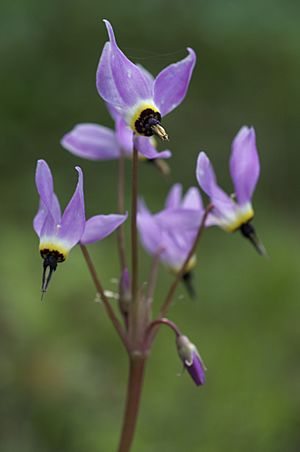Broad-leaved shooting star facts for kids
Quick facts for kids Broad-leaved shooting star |
|
|---|---|
 |
|
| Scientific classification | |
| Synonyms | |
|
List
|
Primula hendersonii is a beautiful flowering plant found in western North America. It belongs to the Primulaceae family. People often call it by fun names like broad-leaved shooting star, Henderson's shooting star, mosquito bills, and sailor caps. You can find this plant growing naturally from California all the way north to southern British Columbia and Idaho.
Contents
What Does This Plant Look Like?
Primula hendersonii is a unique plant because it is summer deciduous. This means it dies back to the ground during the dry summer months. It then grows back when the rains return.
This plant has leaves that grow in clumps near the ground. These leaves can be about 2 to 16 centimeters long. Its flowers hang downwards, like little bells. Each flower is about 6 to 25 millimeters long. They grow on stems that stand 10 to 30 centimeters tall.
The flowers come in many pretty colors. You might see them in magenta, deep lavender, or even white. The stamens, which are the parts that hold pollen, stick out from the flower. The sepals, which are like small leaves that protect the flower bud, bend backward. This plant can look quite different from one place to another. It can also mix its genes with a similar plant called Primula clevelandii. You can often tell Primula hendersonii apart by its reddish or purplish stem.
Where Does Primula hendersonii Grow?
This plant is found in many parts of California. This includes the northwest, the Cascade Range, and the Sierra Nevada foothills. It also grows in the Central Valley, the San Francisco Bay Area, and the San Bernardino Mountains.
You will usually find Primula hendersonii in open woodlands. It can grow at sea level in British Columbia. In California, it can be found at altitudes up to 1,900 meters (about 6,200 feet).
How to Grow This Plant
If you want to grow Primula hendersonii, it needs a few special things. It needs soil that drains water very well. It also needs a dry period in the summer.
If you start these plants from seeds, it might take a while for them to flower. It can take 3 to 5 years before you see any blooms. However, there are ways to speed this up! If you give the plants frequent light fertilizer and enough moisture, they might flower in just 1 to 2 years. Another trick is to put them in a cooler after they go dormant. Then, move them to a shadehouse in midsummer.
You can also grow new plants by dividing the existing ones in winter. This plant prefers shady spots, especially if you live inland.
This beautiful plant has received an important award. It gained the Royal Horticultural Society's Award of Garden Merit. This award means it is an excellent plant for gardens.
Uses of Primula hendersonii
Some parts of the Primula hendersonii plant can be eaten. The leaves and roots can be cooked. They are usually roasted or boiled. However, it is important to know that these parts are reported to be harmful if eaten raw.
See also
 In Spanish: Dodecatheon hendersonii para niños
In Spanish: Dodecatheon hendersonii para niños

